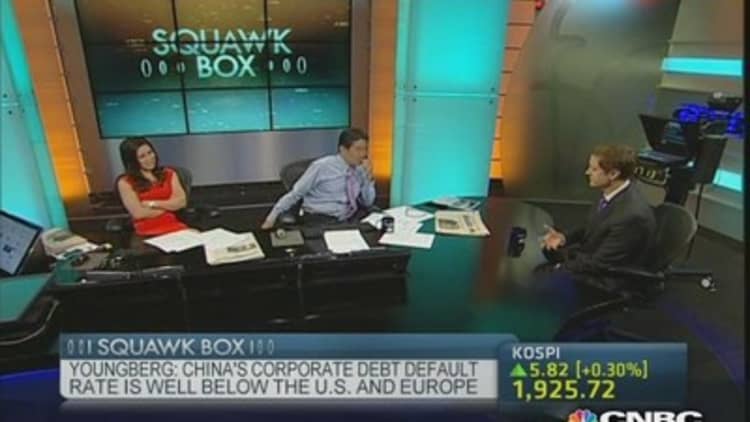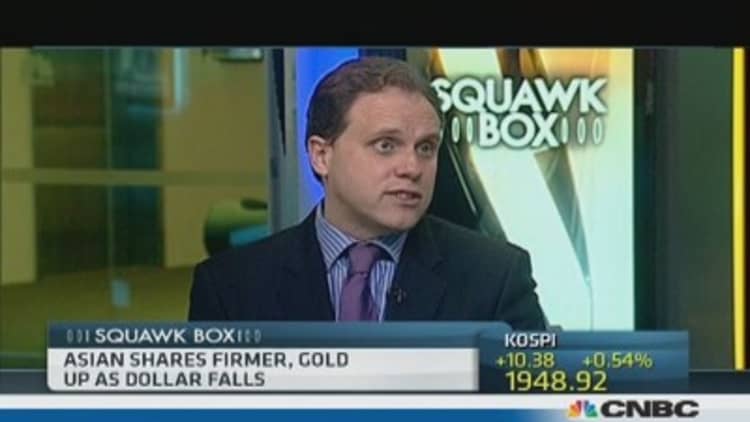
Yield chasers have made high-yield debt one of the most popular asset classes this year, pushing returns to near record lows, and some analysts are concerned the segment is becoming too risky.
"We joke in high yield that it's the asset class formerly known as high yield, because the yield in today's market is below 5 percent," said Todd Youngberg, head of high yield at Aviva Investors, which has around $400 billion under management. He expects returns of around 3-6 percent this year for the high-yield segment, which is often referred to as "junk bonds" for their low credit ratings and higher default risks.
(Read more: Red flag waves over junk bonds as money pours into high yield)
But he noted the ownership of the asset class has changed over the past few years, going from primarily institutional holders to around "half and half" institutional and retail investors. He considers that one of the top risks for the sector.
While institutional investors tend to be longer-term holders of assets, retail investors have a tendency to chase rallies and then rush for the exits when markets are pressured.
For retail investors, "the horse has already gone out of the barn. It's a little too late as spreads are already tight," said Kumar Palghat, a managing director at fixed income manager Kapstream Capital. He noted that returns have gone from around 18 percent in 2008 to around an expected 3.35 percent for the year, based on the iTraxx index.
"There's not a lot of premium on default risk," Palghat added. "You're not being paid enough" at these levels for the risk that's being taken on double-B and single-B rated corporate debt, Palghat said.
(Read more: Global junk bond issuance hits all-time high in 2013)
Globally, high-yield bond funds have been popular with investors this year, with around $10.93 billion flowing into the segment so far this year, according to data from Jefferies. By comparison, U.S. equity funds have seen around $7.9 billion so far this year, the data show.
Concerns over asset quality are rising. Moody's last week said in a note that the quality of covenants that govern high-yield corporate debt are at a record low, with the average covenant quality score for high-yield bonds in February worsening to 4.36 from January's 3.84, the weakest since the rating service began reporting the scores in January 2011. The 1-to-5 scale puts five at the weakest level.
Morgan Stanley is also concerned about the valuations for the sector, even though it expects U.S. high-yield debt default rates will remain below average for the near term.

"This is broadly reflected in current valuations," the bank said in a note. "In the scenario of a risk-off event or significant rise in rates, we see meaningful downside."
Over the longer term, if credit quality deteriorates, it expects the segment will begin to price in expectations for meaningful defaults.
"Whilst we see some scope for outperformance on a total return basis, we do not see current valuations as overly attractive," the bank said.
(Read more: Bonds beating stocks in 2014...so far)
While emerging market corporate debt yields look more attractive compared with U.S. high-yield, Morgan Stanley expects spreads will continue to widen amid deteriorating macro-economic fundamentals as well as political risks, including upcoming elections.
It believes U.S. investment-grade corporate debt offers more attractive risk-reward for investors, with better valuations and low default risk.
To be sure, managers aren't entirely negative on the asset class.
"It is a great way to diversify and get very strong risk adjusted returns," said Aviva Investors' Youngberg. "If you do have rising rates and you do have volatility and you have the back drop of really strong fundamentals of low default rates, 3-6 percent isn't too bad," he said.
"Over the past 25 years, high yield bonds have had similar returns to the major equity markets -- S&P 500, Russell 3000, Wilshire etc. -- but with about half of the risk," he said. "If there's anything that should be junky, maybe it should be equities."
—By CNBC's Leslie Shaffer. Follow her on Twitter @LeslieShaffer1

